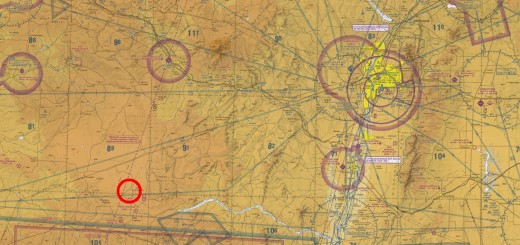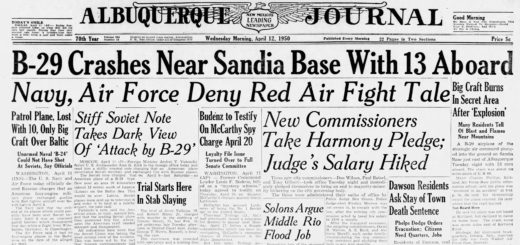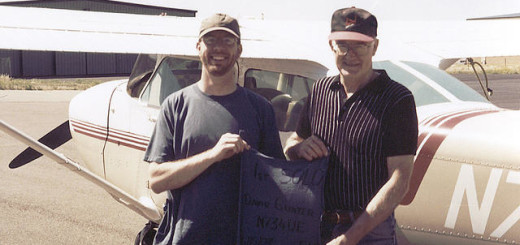Checkride Passed!
Dec. 11
Today was the long awaited, much anticipated checkride. The day began for me at midnight, literally. Unable to sleep, I awoke at 12:39 am and started off by filling out form 8710-1, Airman Certificate and/or Rating Application. The form took a little over 30 minutes to fill out due to the close scrutiny of the instructions and paying attention to exactly
how data was to be written in. I don’t want this form being rejected because I used a slash in place of a dash. I also had to add up all my flying hours to put into the appropriate columns near the bottom of the form.
Next I went over my planned route to Roswell, NM. I logged on to the DUATS system to get the standard weather forecast, notams, TFRs and other information related to the trip. I studied my VFR chart to make sure I understood every symbol and infographic it contained and where to look for answers when something didn’t seem familiar.
Convinced that my planned route was ok I sat down to read more from my review book, Private Oral Exam Guide by Michael D. Hayes. This book is the single most important book one can have before taking a checkride. It is full of questions that an examiner is likely to ask you during the oral portion of the day. It is split into the normal sections akin to
any flight training book and has the answers to each question in sufficient detail and lists where more information on each topic is to be found. Keep in mind that these questions are not limited to the pre-flight portion of the exam. Examiners will ask you other questions in the air so as to distract you or to see how you handle distractions.
At 6 am I stuffed all my gear into my flight bag and headed to IHOP to meet up with Sonya and downed a Texas-style breakfast burrito. With 3 hours left before meeting with the examiner I was feeling pretty good.
I arrived at the airport at 7:40 am and continued to review the Hayes book and arranged everything for the examiners arrival. Larry (my CFI) arrived sometime after that and we went over my planned route and he found a few mistakes with how I had coded some VOR checkpoints. After correcting those he went to work with another student of his who was making his first dual cross-country trip that day. After some more reviewing on my own Larry brought in the maintenance logs for the C172 and I retrieved the registration and other documents from the airplane. All of these need to be shown to the examiner as part of the requirements that I, the pilot in command, had found the plane to be airworthy. The examiner arrived (G.C. Johnson, a very pleasant fellow) and while he was getting coffee I had just enough time to transfer the data from my photo-copied FAA form 8710-1 to the one which would get sent into the FAA. Then it was time to start the exam.
G.C. started off by asking me about the plane and what did I know about whether it was airworthy or not. I showed him the maintenance logs and where the entries were that indicated it had received the necessary annual and 100-hour inspections, the ELT (emergency locator transponder) inspection, and the transponder and static system inspections. Then I showed him the AROW documents: Aircraft airworthiness certificate, Registration, Operators Manual and the Weights and Balance datasheet. I then told him that a final airworthiness determination would be done during the preflight check.
He then spent 5 minutes going over my planned cross-country route to Roswell and convinced himself that I had planned things out well and with enough visual checkpoints and VOR cross-references. He seemed pleased that I had printed out not only the data page for Roswell (ROW) but two other alternate airports as well (Sandia Airpark and Moriarty).
He asked me about the weather during the trip and how I had obtained the information. What the winds aloft were to be and temperatures in Santa Fe and in Roswell. The he asked what I would do if the weather wasn’t as expected and where would I get that information once I was in the air. I told him about HWAS and where we could use that and, failing that, how to contact Flight Services to get in-flight weather info.
Lastly, he looked at the chart and asked bout various portions of it at random, for me to explain the various features. I had planned for this to happen and I did amazingly well and didn’t have to resort to looking at the back-page legends for any information.
And that was it for the oral portion of the exam. I had expected much more questioning into the rules and regulations of flying, or about detailed aeronautical principals and airplane systems. But he ended after reviewing my weather and navigational chart knowledge with a short, “Let’s go flying.”
I packed up all my gear once again only this time I left behind my review materials and FAR/AIM book to ease the clutter in the bag. We went out to the plane and I briefed him on the use of the seat belts (Yes, he knows this but it is part of the FAA regs to brief your passengers on the use of, and when to wear, the seat belts.) I finished my passenger briefing and he followed me around as I went through the preflight inspection. I read each line of the checklist allowed so he could follow along and be assured I was doing the required checking. It was quite cool and windy with gusts up to 20 kts. Because this was for the exam I took a little bit more time during the inspection than usual and thus, we were both eager to get in the plane once I had finished.
Inside the plane I arranged my flight bag behind his seat so that I could retrieve items with little effort. I knew exactly where to grab for my clipboard and plotter and flight computer and also for the pair of blinders to be used during the instrument portion of the exam. Next I went through the startup checklist, started the plane and retrieved the current ATIS info, set the altimeter and requested clearance from ground to Taxi to runway 02. The winds looked as if they favored 33 but I wasn’t about to second guess the tower during my exam.
We taxied to the run-up area of runway 2 and had a nice chat about flying in and around Santa Fe and the coyotes that hang out near the runways. I’d really warmed up to G.C. by this point and my level of nervousness wasn’t nearly what it was earlier that morning.
I finished the run-up went over the what-if take-off scenarios. I first asked him for the type of take-off he’d like to see. He said, “Oh, just a normal take off.” I thought to myself, “Gee…I hadn’t done just a normal take-off in ages,” because I had been doing so many specialty take-offs and landings in preparation for the exam. A normal take-off was what he wanted so that’s what I did. Just before I pulled up to the hold-short line the tower had switched everyone to start using runway 33. We were all set for 2 so that is what we would use but it meant we would have significant cross-wind on the take off. It was a smooth take off roll and lift-off and I promptly rolled the ailerons neutral while putting in just enough crab angle to keep us moving straight along the runway middle line. G.C. told me that I knocked out the cross-wind take-off test nicely.
Normally on take-offs the tower will call out that I am approved to make such-and-such a turnout if it is not the standard left-hand pattern. Since we were taking off from 2 and I needed to head southeast, a right turnout would have been preferred. Since the tower controller hadn’t said this was approved (and I hadn’t asked for it) I made my crosswind turn to the left. The examiner wondered why I was taking the long way around and I explained the above and he said, “Oh, they just expect you to make the turn that will leave you in the airport the shortest amount of time.” Thus, I turned the plane for a right crosswind exit and we were off on my planned route to Roswell, NM. Just around 5 miles out from the airport I radioed our position to the tower and they approved our change of frequency as we left their airspace. In practice, you stay on frequency anyway so you can hear who else may be coming out or heading in your way.
We reached the planned cruising altitude of 9500 ft eight minutes after take-off and just short of the town of Galisteo — exactly where I had planned. This is no small feet given that I am using aircraft performance data from a manual printed for a plane made in 1977. From there I flew the heading I had computed and cross-checked it against the 140 radial from the Santa Fe VOR. As we headed northwest of Moriarty I tuned in and identified the OTO VOR signal and dialed in the correct radial that would indicate I was still on course. At that point G.C. asked me where we were. You have to pin-point the location on the navigational chart and be correct within 3 n.m. I did this and was spot on. We hit our next checkpoint at 22 minutes into the flight, a mere 2 minutes off schedule. G.C. was convinced I could figure out what I was doing at this point and we broke off the cross-country portion of the test.
He had me turn back towards Santa Fe and the practice area we use. I used the turn to do a look out for other traffic (clearing turns need to be done after each maneuver) and that pleased him. In order, he had me perform slow flights, slow flight with turns in either direction, power-on stalls, power-off stalls and then steep turns in both directions.
He then took controls of the plane to allow me to put on my blinders. Then I retook control and followed his instructions to descend 500 ft and level off, do a turn to the west of about 30-degrees to a specified heading, and lastly, to tune in the OTO VOR and fly a course to the VOR. He then took control of the airplane and with my hands and feet off the controls he put the plane into adverse situations from which I had to recover. We did three such situations. A climb with a slight turn, a decent, and a steep decent with a turn. I don’t know if I’m nuts or not, but I love doing those recoveries.
Following the instrument portion of the exam he said to head further back to Santa Fe and pick out a spot to demonstrate turns around a point. As I turned to the heading of 300 he pulled back the throttle for a demonstrated engine-out failure. I glanced briefly to my right and saw the ridges and hills and then to my left with miles upon miles of flat grazing land. I had already started spinning the trim wheel to put the plane in a 65 knot glide and turned it to the left. I pointed out the chosen landing spot and proceeded to fly a pattern that would put us there. However, G.C. then pointed out the private airstrip (Big Sky) that I was over when he pulled the throttle out. What a prime place to land, replete with wind socks even. Lesson learned: When you have 3000 feet to play with you have a little more time to look around and choose a landing spot. However, I had chosen a satisfactory spot to land and I did ok going through the restart procedures and the emergency checklist, naming out who we could contact and on what frequencies. My one mistake is that I had failed to account for the winds, which would have put us on the ground with a tailwind. Around 150 ft from the ground I did the go around procedure and we climbed back to 7500 feet for a few turns around a point.
This time I knew where the winds were and set up for a downwind left-turn around a pair of intersecting dirt roads. The tailwind really blew us into it rather quickly and my first turn was more of an elongated oval. I managed to do an alright, but wide second circle. G.C. was having trouble seeing the intersection and we move to doing a turn around an abandoned house instead. This turned out to be a much easier task than the roads, or else I had adjusted to the winds by then.
Finally it was time to head back to SAF and demonstrate some landings. I went through the pre-landing checklist and obtained the current ATIS info and reset the altimeter. He pulled out the throttle to idle once again and this time I spent a little more effort looking for the best landing spots. In this case there was only one, a farmers field. All round us were nothing but little rolling hills otherwise. I knew where the winds were and I planed a pattern that put us on course to land with a nice headwind. Much better this time.
Once we were back up at altitude I called out to the Santa Fe tower for entering the airspace for touch-and-goes. We were given a straight-in approach to runway 33. G.C. then said it’s a good day to see a short-field landing. I set us up for that, reaching a smooth 60 knot glide to the runway. I said that the winds were strong today so that my flair point over the runway would be closer to the touchdown spot than it would be normally. The touchdown point were the 200 foot stripes, runway aim point markers. Runway 33 has an upslope that almost always throws me off, especially if it is my first landing of the day and I haven’t used 33 in quite a long time. Over the flair point I pulled back on the yoke and then turned my head left to see how high I was off the ground. I pulled a little too far back and we ballooned a little. Thus, what would have been a nice touchdown just on target was a more-than-necessary hard landing. I knew I hit my touchdown point (required to be at or 200 ft beyond a specified target) but as we took off for the next turn in the pattern he said to make the next landing full-stop. Inside I was dumbfounded. I assumed I had just failed the exam and that was it. When I asked what landing he wanted to see on the final one he said it was up to me. I did a nice soft-field landing and we taxied back to the parking area following the post-landing checklist.
Back inside the FBO he chatted about the flight and the areas he thought I was weakest in, including that short-field landing. But to my surprise he pulled out his pad and began filling out the Temporary Airman Certificate. We discussed flying and I told him of my plans for the future, of working towards an instrument rating and so on. It was a pleasant conversation but I was only half paying attention and mostly stifling the urge to yell, “Woohoo!” I gave him his check for the exam and he left. I went and settled accounts with the FBO and that was it.
So that’s how you become a pilot.



Recent Comments